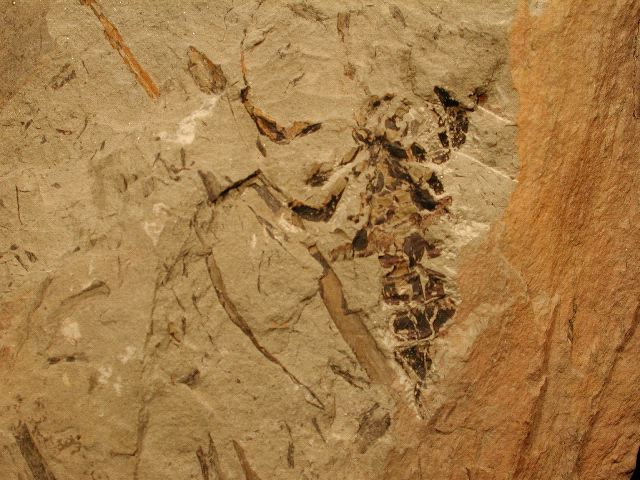Petaloscorpio
In 1964, René Bureau made the startling discovery of a land scorpion fossil at Miguasha.
 (72 kb) The animal would have been 15 centimetres long and was identified as a completely new species. It was named Petaloscorpio bureaui in honour of its discoverer. More discoveries of Petaloscorpio specimens followed, with some parts even preserved in three dimensions.
(72 kb) The animal would have been 15 centimetres long and was identified as a completely new species. It was named Petaloscorpio bureaui in honour of its discoverer. More discoveries of Petaloscorpio specimens followed, with some parts even preserved in three dimensions.
The first true scorpions appeared in the middle of the Silurian Period, but these were aquatic or amphibious creatures equipped with gills like their eurypterid cousins. Scorpions today live in the open air and obtain their oxygen via four pairs of pulmonary sacs. These sacs have an internal structure made up of numerous folds that increase their exposure to air. These same features have been identified in fossil scorpions from the beginning of the Carboniferous Period, indicating that they had conquered land by that time.
It has not been possible to confirm whether pulmonary sacs are present in the Miguasha Petaloscorpio specimens, but their leg structure and the presence of an oral tube for drinking water suggest they were already land-dwelling creatures. If so, Miguasha’s Petaloscorpio and the closely related genus Hubeiscorpio from Upper Devonian rocks in China are the oldest evidence of land scorpions.
Under the abdomen of today’s scorpions is an intriguing sensory organ known as the pectine, a light and fragile structure lined with many small teeth at ground level. Petaloscorpio was equipped with a pectine, as shown by some Miguasha specimens. The fossilization of this delicate organ is yet another demonstration of the marvellous capacity for preservation in the ancient Miguasha environment.
Today’s global distribution of land scorpions is limited to within 50 degrees latitude on either side of the equator. Assuming that earlier scorpions had the same climate requirements, their presence at Miguasha is not surprising because this part of the Appalachians was slightly south of the equator during Devonian time. The many carapace microfragments found among plant fragments at Miguasha tells us that scorpions were quite common along the shores of this Devonian estuary.

 (72 kb) The animal would have been 15 centimetres long and was identified as a completely new species. It was named Petaloscorpio bureaui in honour of its discoverer. More discoveries of Petaloscorpio specimens followed, with some parts even preserved in three dimensions.
(72 kb) The animal would have been 15 centimetres long and was identified as a completely new species. It was named Petaloscorpio bureaui in honour of its discoverer. More discoveries of Petaloscorpio specimens followed, with some parts even preserved in three dimensions.The first true scorpions appeared in the middle of the Silurian Period, but these were aquatic or amphibious creatures equipped with gills like their eurypterid cousins. Scorpions today live in the open air and obtain their oxygen via four pairs of pulmonary sacs. These sacs have an internal structure made up of numerous folds that increase their exposure to air. These same features have been identified in fossil scorpions from the beginning of the Carboniferous Period, indicating that they had conquered land by that time.
It has not been possible to confirm whether pulmonary sacs are present in the Miguasha Petaloscorpio specimens, but their leg structure and the presence of an oral tube for drinking water suggest they were already land-dwelling creatures. If so, Miguasha’s Petaloscorpio and the closely related genus Hubeiscorpio from Upper Devonian rocks in China are the oldest evidence of land scorpions.
Under the abdomen of today’s scorpions is an intriguing sensory organ known as the pectine, a light and fragile structure lined with many small teeth at ground level. Petaloscorpio was equipped with a pectine, as shown by some Miguasha specimens. The fossilization of this delicate organ is yet another demonstration of the marvellous capacity for preservation in the ancient Miguasha environment.
Today’s global distribution of land scorpions is limited to within 50 degrees latitude on either side of the equator. Assuming that earlier scorpions had the same climate requirements, their presence at Miguasha is not surprising because this part of the Appalachians was slightly south of the equator during Devonian time. The many carapace microfragments found among plant fragments at Miguasha tells us that scorpions were quite common along the shores of this Devonian estuary.
Site map | Feedback | Links | Sources | Credits
Petaloscorpio
<< Zanclodesmus | Vertebrates >>

Title: Petaloscorpio bureaui
Author: Parc national de Miguasha
Sources: Parc national de Miguasha
Year: 2002
Description:
A land-dwelling scorpion crawled along the shores of the ancient Miguasha estuary during Upper Devonian time. The animal was named Petaloscorpio bureaui in honour of the Quebecer René Bureau.


